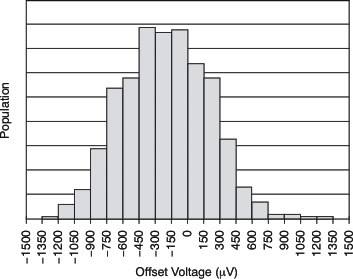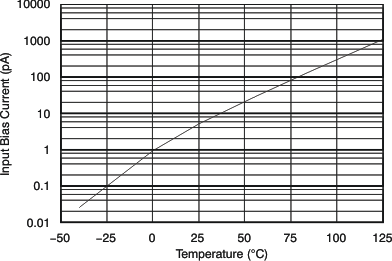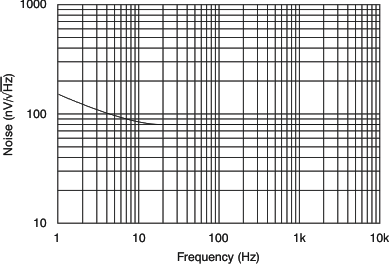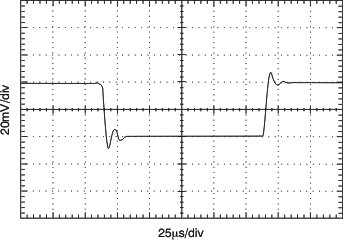ZHCSEY0B April 2016 – August 2017 TLV2379 , TLV379 , TLV4379
PRODUCTION DATA.
7 Specifications
7.1 Absolute Maximum Ratings
over operating free-air temperature range (unless otherwise noted)(1)| MIN | MAX | UNIT | ||
|---|---|---|---|---|
| Voltage | Supply, VS = (V+) – (V–) | 7 | V | |
| Signal input pin(2) | (V–) – 0.5 | (V+) + 0.5 | ||
| Current | Signal input pin(2) | ±10 | mA | |
| Output short-circuit(3) | Continuous | |||
| Temperature | Operating, TA | –40 | 125 | °C |
| Junction, TJ | 150 | |||
| Storage, Tstg | –65 | 150 | ||
(1) Stresses beyond those listed under Absolute Maximum Ratings may cause permanent damage to the device. These are stress ratings only, which do not imply functional operation of the device at these or any other conditions beyond those indicated under Recommended Operating Conditions. Exposure to absolute-maximum-rated conditions for extended periods may affect device reliability.
(2) Input pins are diode-clamped to the power-supply rails. Input signals that can swing more than 0.5 V beyond the supply rails must be current-limited to 10 mA or less.
(3) Short-circuit to ground, one amplifier per package.
7.2 ESD Ratings
| VALUE | UNIT | |||
|---|---|---|---|---|
| V(ESD) | Electrostatic discharge | Human-body model (HBM), per ANSI/ESDA/JEDEC JS-001(1) | ±2000 | V |
| Charged-device model (CDM), per JEDEC specification JESD22-C101(2) | ±1000 | |||
(1) JEDEC document JEP155 states that 500-V HBM allows safe manufacturing with a standard ESD control process.
(2) JEDEC document JEP157 states that 250-V CDM allows safe manufacturing with a standard ESD control process.
7.3 Recommended Operating Conditions
over operating free-air temperature range (unless otherwise noted)| MIN | NOM | MAX | UNIT | |||
|---|---|---|---|---|---|---|
| VS | Supply voltage | Single supply | 1.8 | 5.5 | V | |
| Dual supply | ±0.9 | ±2.75 | ||||
| TA | Operating temperature | –40 | 125 | °C | ||
7.4 Thermal Information: TLV379
| THERMAL METRIC(1) | TLV379 | UNIT | |||
|---|---|---|---|---|---|
| DCK (SC70) | DBV (SOT23) | D (SOIC) | |||
| 5 PINS | 5 PINS | 8 PINS | |||
| RθJA | Junction-to-ambient thermal resistance | 262.2 | 220.8 | 130.8 | °C/W |
| RθJC(top) | Junction-to-case (top) thermal resistance | 99.7 | 148.3 | 77.2 | °C/W |
| RθJB | Junction-to-board thermal resistance | 49.0 | 48.2 | 71.1 | °C/W |
| ψJT | Junction-to-top characterization parameter | 3.3 | 28.6 | 30.7 | °C/W |
| ψJB | Junction-to-board characterization parameter | 18.2 | 47.3 | 70.6 | °C/W |
| RθJC(bot) | Junction-to-case (bottom) thermal resistance | n/a | n/a | n/a | °C/W |
(1) For more information about traditional and new thermal metrics, see the Semiconductor and IC Package Thermal Metrics application report.
7.5 Thermal Information: TLV2379
| THERMAL METRIC(1) | TLV2379 | UNIT | |
|---|---|---|---|
| D (SOIC) | |||
| 8 PINS | |||
| RθJA | Junction-to-ambient thermal resistance | 116.4 | °C/W |
| RθJC(top) | Junction-to-case (top) thermal resistance | 59.5 | °C/W |
| RθJB | Junction-to-board thermal resistance | 57.6 | °C/W |
| ψJT | Junction-to-top characterization parameter | 17.2 | °C/W |
| ψJB | Junction-to-board characterization parameter | 57.0 | °C/W |
| RθJC(bot) | Junction-to-case (bottom) thermal resistance | n/a | °C/W |
7.6 Thermal Information: TLV4379
| THERMAL METRIC(1) | TLV4379 | UNIT | |
|---|---|---|---|
| PW (TSSOP) | |||
| 14 PINS | |||
| RθJA | Junction-to-ambient thermal resistance | 110.8 | °C/W |
| RθJC(top) | Junction-to-case (top) thermal resistance | 35.2 | °C/W |
| RθJB | Junction-to-board thermal resistance | 53.6 | °C/W |
| ψJT | Junction-to-top characterization parameter | 2.6 | °C/W |
| ψJB | Junction-to-board characterization parameter | 52.9 | °C/W |
| RθJC(bot) | Junction-to-case (bottom) thermal resistance | n/a | °C/W |
7.7 Electrical Characteristics: VS = 1.8 V to 5.5 V
at TA = 25°C, RL = 25 kΩ connected to VS / 2, and VCM < (V+) – 1 V (unless otherwise noted)| PARAMETER | TEST CONDITIONS | MIN | TYP | MAX | UNIT | |
|---|---|---|---|---|---|---|
| OFFSET VOLTAGE | ||||||
| VOS | Input offset voltage | VS = 5 V | 0.8 | 2.5 | mV | |
| dVOS/dT | VOS drift | TA = –40°C to +125°C | 3 | μV/°C | ||
| PSRR | Power-supply rejection ratio | 92 | 104 | dB | ||
| INPUT VOLTAGE RANGE | ||||||
| VCM | Common-mode voltage range | (V–) – 0.1 | (V+) + 0.1 | V | ||
| CMRR | Common-mode rejection ratio(1) | (V–) < VCM < (V+) – 1 V | 85 | 100 | dB | |
| TA = –40°C to +125°C, (V–) < VCM < (V+) – 1 V |
62 | |||||
| INPUT BIAS CURRENT | ||||||
| IIB | Input bias current | VS = 5 V, VCM ≤ VS / 2 | ±5 | pA | ||
| IIO | Input offset current | VS = 5 V | ±5 | pA | ||
| INPUT IMPEDANCE | ||||||
| Differential | 1013 || 3 | Ω || pF | ||||
| Common-mode | 1013 || 6 | Ω || pF | ||||
| NOISE | ||||||
| Input voltage noise | f = 0.1 Hz to 10 Hz | 2.8 | μVPP | |||
| en | Input voltage noise density | f = 1 kHz | 83 | nV/√Hz | ||
| OPEN-LOOP GAIN | ||||||
| AOL | Open-loop voltage gain | VS = 5 V, RL = 5 kΩ, 500 mV < VO < (V+) – 500 mV |
90 | 110 | dB | |
| OUTPUT | ||||||
| Voltage output swing from rail | RL = 5 kΩ | 25 | 50 | mV | ||
| TA = –40°C to +125°C, RL = 5 kΩ | 75 | |||||
| ISC | Short-circuit current | ±5 | mA | |||
| CLOAD | Capacitive load drive | See Capacitive Load and Stability section | ||||
| ROUT | Closed-loop output impedance | G = 1, f = 1 kHz, IO = 0 | 10 | Ω | ||
| RO | Open-loop output impedance | f = 100 kHz, IO = 0 | 28 | kΩ | ||
| FREQUENCY RESPONSE (CLOAD = 30 pF) | ||||||
| GBW | Gain bandwidth product | 90 | kHz | |||
| SR | Slew rate | G = 1 | 0.03 | V/μs | ||
| Overload recovery time | VIN × Gain > VS | 25 | μs | |||
| tON | Turn-on time | 1 | ms | |||
| POWER SUPPLY | ||||||
| VS | Specified, operating voltage range | 1.8 | 5.5 | V | ||
| IQ | Quiescent current per amplifier | VS = 5 V, TA = –40°C to +125°C | 4 | 12 | μA | |
| TEMPERATURE | ||||||
| TA | Specified, operating range | –40 | 125 | °C | ||
| Tstg | Storage range | –65 | 150 | °C | ||
(1) See typical characteristic graph, Common-Mode Rejection Ratio vs Frequency (Figure 2).
7.8 Typical Characteristics
at TA = 25°C, VS = 5 V, and RL = 25 kΩ connected to VS / 2 (unless otherwise noted)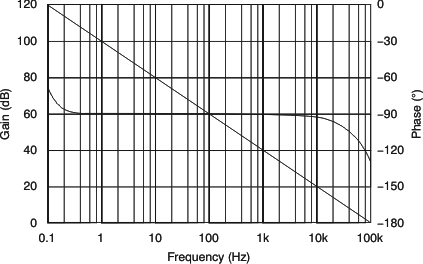
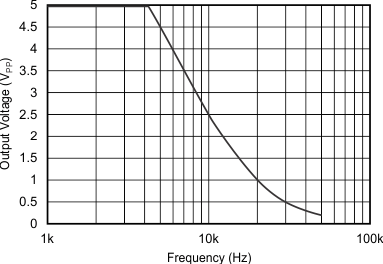
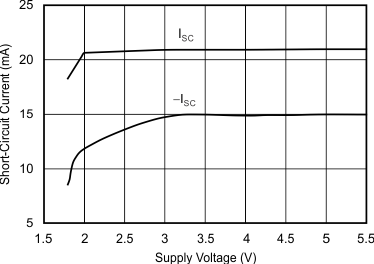

and Temperature
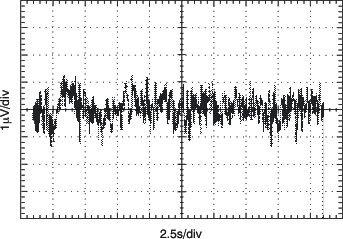
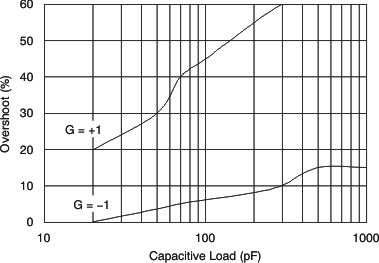
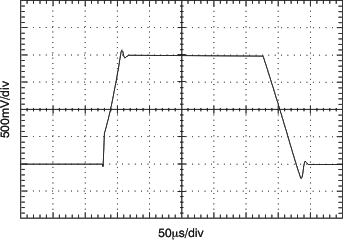
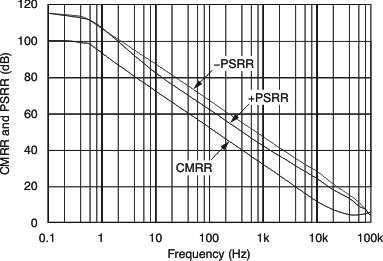
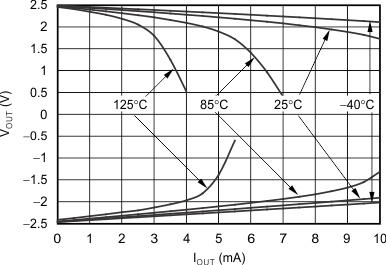
| VS = ±2.5 V |
